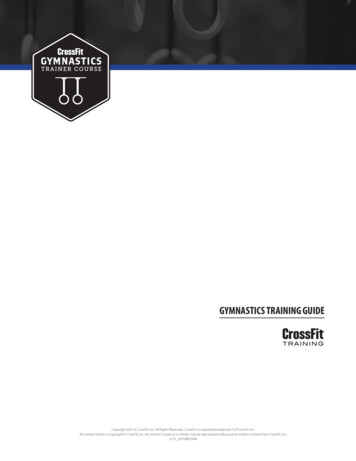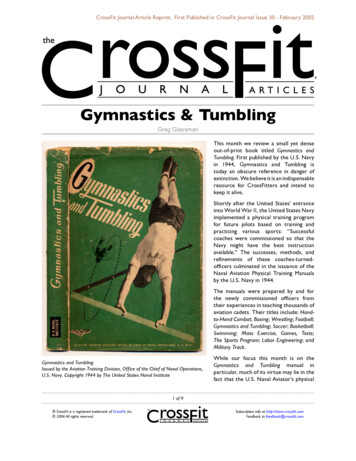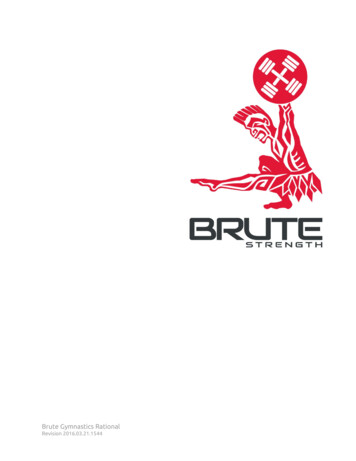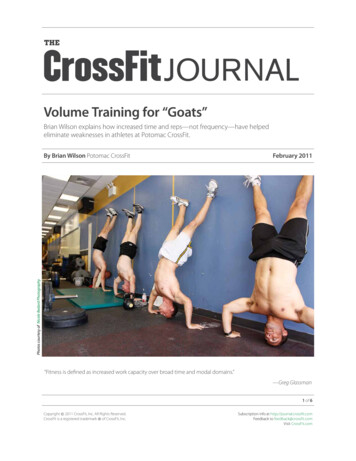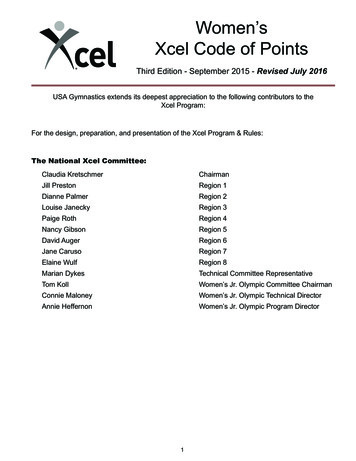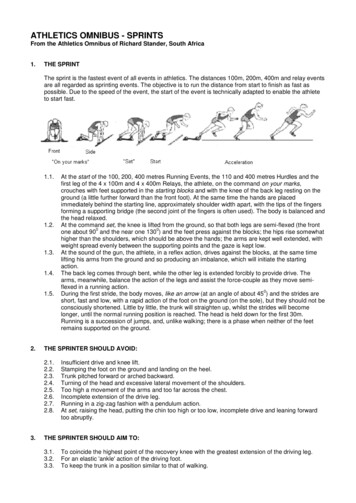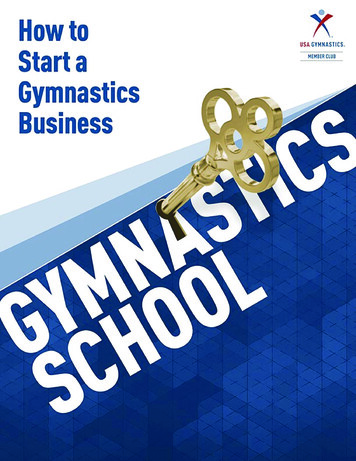
Transcription
How to Start a Gymnastics Business1
2How to Start a Gymnastics Business
2015 EditionHow to Start aGymnastics Businessby Michael A. TaylorPublished by USA Gymnastics 2015 USA Gymnastics. All rights reserved. 19.95How to Start a Gymnastics Business3
TABLE OF CONTENTSDisclaimer. 6SECTION II - OPERATING A GYMNASTICS BUSINESSAcknowledgements. 7Chapter Five – Policies and Procedures (Organizingyour Business)Preface. 7SECTION I - STARTING A NEW BUSINESSChapter One – Business BasicsWhy do you want to start your own business? . 11You are the critical factor. 11What kind of business should you start? . 11Will your business succeed?. 12Becoming a USA Gymnastics Member Club. 12Chapter Two – Choosing the Right Legal BusinessStructureHow to Get Started. 37Employment Issues. 38Operational Issues. 38Manual Dos and Don’ts. 39Unwritten Rules. 40Documentation. 40Preservation and Retention of Documentation. 41Chapter Six – Human Resources (Staffing your Business)The Main Legal Business Structures. 13Employment Interviews. 45Sole Proprietorship. 13Employment Principles. 47Pass – Through Taxation. 14Managing a Multi-Generational Workforce. 47Partnerships. 14Organizational Leadership. 48Limited Liability Company (LLC). 15Employee or Independent Contractor. 49Corporations. 17Safety Practices in Hiring Staff. 51LLCs vs. Corporations. 18Preventing Child Abuse. 51Choosing the Best Structure for Your Business. 19USA Gymnastics Background Checks. 52Analyzing Your Risks. 19US Olympic Committee Safe Sport Program. 52Government Requirements– Federal, State, & Local. 20USA Gymnastics We Care Campaign. 53Free and Low Cost Legal Resources. 20Post Hiring Orientation and Training. 53Chapter Three – Business PlanningA Business Plan is Essential . 23Outline of a Typical Business Plan. 24Vision, Mission, and Values for your Business . 25Facilities Planning. 25Equipment Planning. 30Chapter Four – Sound Financial Planning4Policies and Procedures Principles. 37TB Testing. 53USA Gymnastics University. 54Employee Overtime. 54Vacation and Time Off Requests. 55Employee Evaluations. 56Positive Coaching Your Staff. 56Mentorship in Gymnastics Organizations. 58Characteristics of a Good Mentor. 59Employment Rules and Policies Manual. 61Start Up Financing. 33Staff training. 61Small Business Administration Programs. 35Staff Responsibilities . 62Establishing Fees for Your Programs. 35Performance Management. 64How to Start a Gymnastics Business
Anti-Harassment and WorkplaceViolence Prevention. 65Easy Ways to Reward Your Staff . 65New Student Risks. 105Insurance. 106Professional Memberships and Networking. 66USA Gymnastics University Safety and RiskManagement Certification. 107Conducting Effective Staff Meetings . 68Administration Operations Risk. 107Employee Performance Evaluations. 69Seven Habits of Highly Effective GymnasticsProfessionals. 70Chapter Seven – Gymnastics Operations (Running yourBusiness)USA Gymnastics Programs. 79Gym Culture. 80Improving Operations Checklist. 81Post-Registration Customer Service. 82Teaching Gymnastics. 82Benefits of Participation in Gymnastics. 82Statistical Benefits of Gymnastics. 83Coaches Role in Developing Assets in Youth. 84Five Best Practice Things to Say When You Coach . 85Core Teaching Principles. 86Lesson Planning . 86Facility Considerations. 108Equipment Considerations. 108Participant Considerations. 112Accident Prevention. 112Specific Safety Concerns. 113Emergency Action Plans. 114Incident Reports. 115Dealing With the Media After a Crisis. 115Employer Risk Management. 116Managing Social Media Risks. 118Blood Borne Pathogens. 118Contagious Disease Exposures. 120Ergonomics for Coaches. 120Keep it Safe. 122Teaching DON’T list. 89Chapter Nine – Developing your Business (Helping yourBusiness Grow)Points of Good Supervision . 89Programs. 128Class Management. 90Five Step Approach toProblem Solving and Conflict Resolution . 93Positive Coaching a Competitive Gymnast. 94Student Responsibilities . 94Parent Responsibilities. 96Conducting Parent Booster Club Meetings. 97Chapter Eight – Risk Management (Protecting yourBusiness)Equipment. 128Services. 129Aesthetics. 129Fees . 129Expanding your Business. 129Branding your Business. 129Communications Technology. 131Social Media Marketing. 133Press Releases. 134Legal Responsibilities. 101Annual Program Reviews. 136Risk Assessment. 102Dealing with Mistakes. 137Risk Control Selection. 102Risk Control Implementation. 103References & Resources. 141Waivers and Hold Harmless Agreements. 103Appendix. 143How to Start a Gymnastics Business5
DISCLAIMERThis publication is intended for reference information only, and presentstools for consideration in establishing a model of operations and examplesof best practice systems. It is not intended to be used as a complete solutionto all gymnastics club operations and gymnastics programs, and the use ofthe information included herein is the choice and responsibility of the user.It is recommended that an attorney be consulted for any matters relating toliability and legal issues, particularly in the use of the sample forms included.Information provided in this publication has been prepared by the Author andis published by USA Gymnastics as a service to the gymnastics industry. Itdoes not contain all information about all possible business operation issues,nor does contain all information that may be relevant to particular businessoperation situations. The information provided is of general application, andintended to facilitate communications and discussions between gymnasticsprofessionals, including coaches, teachers, administrative and managementstaff, accountants, attorneys and other professional advisors. The informationcannot be relied upon as a substitute for seeking guidance from appropriateprofessionals such as accountants, legal counsel and insurance advisors.User acknowledges and agrees that neither the Author nor USA Gymnasticsis responsible or liable for the results of the user’s decisions and actionsresulting from the information in this publication, including, but not limited to,a user pursuing or not pursuing advice from business planning professionalssuch as accountants, attorneys and insurance advisors.The information provided in this publication is provided “as-is” andwithout warranties or conditions of any kind, either expressed or implied.To the fullest extent permitted by applicable law, the Author and USAGymnastics expressly disclaim all warranties and conditions, express orimplied, including, but not limited to, warranties and conditions of quality,correspondence to description and fitness for a particular purpose. Neitherthe Author nor USA Gymnastics warrant or represent that the informationprovided in this publication will be correct, accurate, timely, or reliable forany particular situation, circumstance or user.While this publication may be updated periodically, unless and until thatoccurs, any changes in law, rules, regulations, requirements, or best practicesmay cause the information and forms provided in this publication to becomeout-of-date, with respect to which neither Author nor USA Gymnastics acceptany responsibility or liability.To the fullest extent permitted by applicable law, under no circumstances,including, but not limited to negligence, shall the Author or USA Gymnasticsbe liable for any direct, indirect, incidental, special or consequentialdamages, or lost profits, that result in any manner from the use of or relianceon information provided in this publication“Best practices” are sometimes defined as a technique or methodology that, through experienceand research, has been proven to reliably lead to a desired result. “Best practices” evolve over timeas improvements are discovered.6How to Start a Gymnastics Business
ACKNOWLEDGMENTSThe Author would like to thank the staff and the organization ofUSA Gymnastics, particularly Loree Galimore, Cheryl Jarrett, andLynn Moskovitz-Thompson for providing me with the opportunityto contribute to the continued success of the gymnastics industry.I would also like to thank my wonderful wife, Kristy Roos-Taylorfor her patience and understanding as I pursue my passion ofsafety, education and continuous improvement for the sport ofgymnastics.USA Gymnastics would like to thank Michael Taylor for his timeand efforts in writing this book. Also, thank you to Krissy Klein,Woody White, Elizabeth Dooms, Stephanie Marron, and LaKeshaHutchinson for their input and time in creating the final product.PREFACESo you think you want to start your own gymnastics business.Congratulations! You have taken an important first step—gettinginformation. USA Gymnastics developed this booklet with twogoals in mind—to help you determine if starting a club is the rightdecision for you, and to improve your chances of success with yournew business, or to make your current gymnastics school moresuccessful.The first section of this book deals with starting your new businessand the second part of the book is the details in operating yourbusiness. You may feel that there are more questions thananswers, but we have tried to highlight the myriad of issues youwill face before you even open the doors to your new club, or makeyour business better. Wherever possible, we have included optionsfor you to consider or provided typical ranges and solutions.The end of this book includes the appendices that include severalresources on a variety of business-related topics. Since so many ofthe steps involved in opening a gymnastics school are intertwined,we suggest you read through this entire manual first before youget started.Reading through this booklet and watching the videos is only thefirst step. If you conclude that you are ready to get started openingyour own gymnastics school, you have lots of work to do! And USAGymnastics is ready to help. Just look at all the resources we haveavailable to club owners on www.usagym.org.How to Start a Gymnastics Business7
Find out more aboutUSA GYMNASTICSMEMBER SERVICESVisit usagym.org Call 800.345.47198How to Start a Gymnastics Business
SECTION ONESTARTING A NEW BUSINESSOnce upon a time, small business owners were lookedupon as non-conformist, idiosyncratic outsiders thatcouldn’t handle the corporate life and “working fora living.” Today, entrepreneurs are heroes and rolemodels. Almost everyone wants to own his or her ownbusiness – it is the real American dream.We are in the midst of the largest entrepreneurialsurge ever seen. According to the SmallBusiness Administration (SBA), there are28.2 million small businesses in theU.S. in 2011. The SBA defines a smallbusiness as an independent businesshaving fewer than 500 employees.This would include basically allgymnastics businesses. Smallbusiness accounted for 63 percentof the net new jobs between 1993and mid-2013 (or 14.3 millionof the 22.9 million net new jobs).About half of all new establishmentssurvive five years or more and aboutone-third survive 10 years or more. Theentrepreneurial rate in the U.S. is already wellabove the dot.com bubble of 20 years ago, with over543,000 new businesses getting started each month.Although we have slipped a bit recently from the highpoint of 320 new entrepreneurs out of 100,000 adults,65% of the net new jobs come from small business.Becoming your own boss has become a nationalobsession.This book is not intended to be the end-all road map foryour success as the owner of a gymnastics business.Rather, the goal is to give you some information thatwill help guide your decisions and planning. These bestpractices are deliberately presented with the hope thatyou will continue to educate yourself on how to run asuccessful organization.The gymnastics industry has evolved over the years andmany great books have been published relating to thesport, but most have focused on athlete training, skilldevelopment, coaching principles, and conditioning.There have been a few gymnastics business relatedbooks printed, but How to Start a Gymnastics Businessis intended to establish some standards for successfuloperation of gymnastics organizations. It is my hope toraise the standard by which gym owners operate theirHow to Start a Gymnastics Businessbusinesses and conduct their operations. My goal isthat the gymnastics industry becomes the benchmarkby which other youth sport businesses are judged.The most difficult task in preparing this guidebookwas trying to organize the content in a logical andprogressive way that would allow the reader theopportunity to follow along in a sequential order orto pick and choose the content of the mostinterest. With that, please understandthat there is considerable overlap insome of the content, particularlyin regard to personnel / humanresources (staffing) issues andrisk management as well as withcustomer service and programpractices.If you are looking for ideas incertain areas, look about themanual, if you don’t find what you arelooking for in the first place you thinkof keep looking. With this manuscript, acompilation of articles and information basedon common sense, recommendations from variousprofessional organizations, authors and experts, Ieagerly share some experience and knowledge in aneffort to present “How to Start a Gymnastics Business.”Topics will be presented for your consideration,alternative options will be investigated, and sometechniques will be given to help organizations improvetheir operations through best practices of operatingpolicies and procedures, risk management, humanresources, business planning, etc.As solutions are presented to these and other ideas,please understand that this publication is a dynamicwork in progress. You are receiving a manual thatis currently not fully formatted to address all bestpractices. This is a “living document” and it is my hopeto continue to revise and update this book in the future.As times change, our responses as business peopleneed to change. There may be no definitive answerto some questions and issues, and in some instancesI offer a number of options. Just like in the sport ofgymnastics, all we can do is prepare to the best of ourability, try our best when it is time to perform, nevergive up, and strive to be getting better all the time!9
10How to Start a Gymnastics Business
CHAPTER ONEBUSINESS BASICSWhy do you want to start your own business?Most gymnastics teachers and coaches do not owna gym. They either teach or coach in someone else’sgym or they work within a school, a YMCA, or someother not-for-profit based organization. If your goal isto teach and coach gymnastics, there are thousandsof opportunities available to you within the existinggymnastics community. And as we shall see, in manycases you will make more money and have fewerresponsibilities if you work for someone else than if youopen your own gym.In view of these sobering facts, it is imperative that yoube clear on why you want to open a gymnastics school.In most cases the simple desire to teach and coachgymnastics and the skill set that you have developed asa gymnastics teacher will not be enough to make yourdream or owning a gymnastics school a reality or atleast a very pleasant reality.In most cases the reason to open a gymnasticsbusiness is exactly the same as the reason to openany other business. Businesses are formed in orderto make a profit. The way you will try make a profit isthrough opening a gymnastics center, but the goal willbe to make a profit.If this seems harsh or uncaring you need only reflect onthe fact that it is very difficult to do a great job teachinggymnastics if you cannot pay the rent, if the gas isdisconnected, or if the paychecks do not clear the bank.Trust me, your employees will not settle for the simplejob of seeing a child’s eyes light up the first time theymake a back handspring by themselves. They will alsowant to get paid.And of course you will want to get paid as well. After allsince it is your gym you are the one who has invested themoney, time, and effort into getting the gym business upand running and it is you who has taken all the risk. Ifanyone deserves to get paid, it is you. And yet the truthis that the owner gets paid last. If there is anything leftafter all the bills are covered and the employees paid(along with the taxes and benefits), and if sufficient fundshave been set aside for upcoming bills and expenses,then and only then, does the owner get compensated forall his or her hard work and investment.If all of this sounds difficult you are starting to get theidea. It is difficult. There is nothing easy about it. ButHow to Start a Gymnastics Businessit can be rewarding and very, very exciting to watchsomething terrific take shape and grow where nothingexisted before.You are the critical factorYou are your own boss. What does it mean to be theboss? Does it mean that you get to order everyonearound and give everyone else the tough jobs while yousit back and coach the team kids? It can if you want todo everything yourself. Because no one will be willingto work for you if you act like that. So, what does beingthe boss mean?It means that you take all the risk, you work the hardest,you lead by example, you take the tough jobs, and youget all the phone calls that no one wants to take.It also means that you set the standards, you chartthe direction the gym will take, you set the gym up theway you want it organized, you work only with thoseyou want to work with, and you get to see your dreamtake shape. You also reap any profits the gym mightgenerate.What kind of business should you start?Before starting a business, one of the most importantdecisions to make is what type of business you want.For many beginning entrepreneurs, deciding what typeof business to start is a difficult consideration. Becauseyou are reading this book, you are obviously halfwaytoward making a decision. Since you are reading thisbook, you are either interested in start ing a gymnasticsschool or desperate for something to read.Saying you want to start a gymnastics school is verymuch like saying you want to buy a car. What kind of cardo you want? Toyota? Ford? Cadillac? SUV? Or Tesla?The possibilities are amazing and totally different - incars as well as gymnastics busi ness types. In thisdecision process, first consider why do you want to opena gym? Next think about what your skills sets are thatmake you likely to do well at owning a club. What youwould like to do? How good you are at managing peopleand money? Do you have the time and energy you haveto devote to these important tasks?Then consider the many decisions that will determineyour school’s approach? How large do you want yourfacility to be? Do you want a mobile program operated11
from a van or a bus? Will you offer boys’ and girls’instructional programs? Will you offer preschoolprograms? Competition programs? Junior Olympic,Xcel, or Elite program? Gymnastics for All performancegroups? Adult pro grams? Recreational classes or Acroonly? Birthday Parties, Open Gyms, or Parent’s NightOut? Will you offer auxiliary programs like rock climbing,dance or karate? Cheerleading? Trampoline andtumbling? The list of possibilities grows larger each yearwith gym clubs adding programming like swimming,ice-skating and even educational preschools.Deciding what you want, honestly assessing why youwant to start a club, and what skills you possess andwhich ones you lack before you begin, and then workingbackward is the best way to plan your success. Withyour vision firmly in mind, use the process of “reengineering” the concept to end at the beginning. If youwant a closely held small gym business run by you anda few select associates, your plan will look very differentthan that of a large, complex multi-sport facility that ismanaged by you, but run by others.Will your business succeed?Once you have decided to start your own business, youneed to define and sell your “product.” What are youselling? To whom are you selling? Why are you sellingthis particular product or service? Is there a market?How much are you going to charge?Nothing happens in business until something is sold.Selling is an essential part of a suc cessful business,but many people shy away from sales because they donot want to feel they are manipulating the customer.Sales and manipulation are very different interactions.Manipulation is convincing a person to take yourproduct or service regardless of their needs. This maycause a person to resent you and your company. Sellingis the process of matching your product or service tothe customer’s needs. The first step is to determinewhether or not the person wants or needs what youhave to sell. There is a great deal of information on thesales process available at libraries and bookstores.Selling is an art form that requires practice, so do yourhomework.Becoming a USA Gymnastics Member ClubBranding your new business one of the most importantaspects of being successful and will be discussed atlength in another chapter. As the National GoverningBody (NGB) of the sport of gymnastics, USA Gymnasticsis recognized and respected throughout the world.There is no easier or better way to brand your new gymthan with USA Gymnastics. One of your first tasks as12an owner of a new gymnastics business is to become amember club by clicking HERE to sign up.In addition to the credibility that becoming a USAGymnastics Member Club brings to your gym club,being a member club will help as you begin and growyour business with a host of resources available to ourMember Clubs and our USA Gymnastics University.In DepthThis handbook’s purpose is to provide generalinformation, not to give legal or specific businessadvice. No legal advice can be given because lawsvary from state to state, laws are in a constant stateof change due to legislation, and circumstancesof particular matters that arise in gymnas tics alsovary widely and cannot be predicted in advance.For all of these reasons, every gymnastics clubshould retain local legal counsel to address all legalissues. Clubs should seek counsel regarding hiringand employment practices, and risk managementpolicies and procedures, and should also contacttheir attorney immediately after any incident forguidance and direction.Key Points Before starting any business, new owners shouldbe clear in their own personal reasons for startingthe business. The gym owner is the de facto leader, regardlessof the organization. Even in a “turn-key” operationwith directors and managers running thebusiness, the gym owner is the ultimate authoritywith final responsibility. Gymnastics is a broad-based industry thatencompasses many activities and services. Gymowners should avoid trying to do everything andrisk not doing anything well. Razor sharp focus onpriorities will help ensure a successful business. Perhaps the single most important decision anew gym owner can make is to become a MemberClub of USA Gymnastics to take advantage ofthe many resources made available to USAGymnastics Member Clubs.How to Start a Gymnastics Business
CHAPTER TWOSELECTING THE RIGHT LEGAL BUSINESS STRUCTUREThe Main Legal Business StructuresYou probably already have a rough idea of the type oflegal structure your business will take, whether youknow it or not. That’s because the ownership structurethat’s right for your business—a sole proprietorship,partnership, LLC, or corporation—depends on howmany people will own the business and what typeof services or products it will provide, things you’veundoubtedly thought about quite a bit.For instance, if you know that you will be the onlyowner, then a partnership is obviously not your thing.And if your business will engage in risky activities(for example, gymnastics!), you’ll not only want to buyinsurance, but also consider forming an entity thatprovides personal liability protection, which can shieldyour personal assets from business debts and claims. Ifyou plan to raise capital by selling stock to the boosterclub or want to give your employees stock options, thenyou should form a corporation.If you’ve considered these issues, then you’ll be aheadof the game in choosing a legal structure that’s right foryour business. Still, you’ll need to consider the benefitsand drawbacks of each type of business structurebefore you make your final decision.In all states, the basic types of business structures are: Sole proprietorships, Partnerships (general and limited), Limited liability companies (LLCs), and Corporations.To help you pick the best structure for your business,this chapter explains the basic attributes of each type.And it will also help you answer the most commonquestion new entrepreneurs ask about choosing abusiness form: Should I choose a business structurethat offers protection from personal liability—acorporation or an LLC? Here’s a hint as to what thebest advice will be: If you focus energy and moneyinto getting your business off the ground as a soleproprietorship or a partnership, you can alwaysincorporate or form an LLC later.Sole ProprietorshipTechnically, a sole proprietorship is simply a businessthat is owned by one person and that hasn’t filed papersHow to Start a Gymnastics Businessto become a corporation or an LLC. Sole proprietorshipsare easy to se
How to Start a Gymnastics Business 7 PREFACE So you think you want to start your own gymnastics business. Congratulations! You have taken an important first step—getting information. USA Gymnastics developed this booklet with two goals in m
